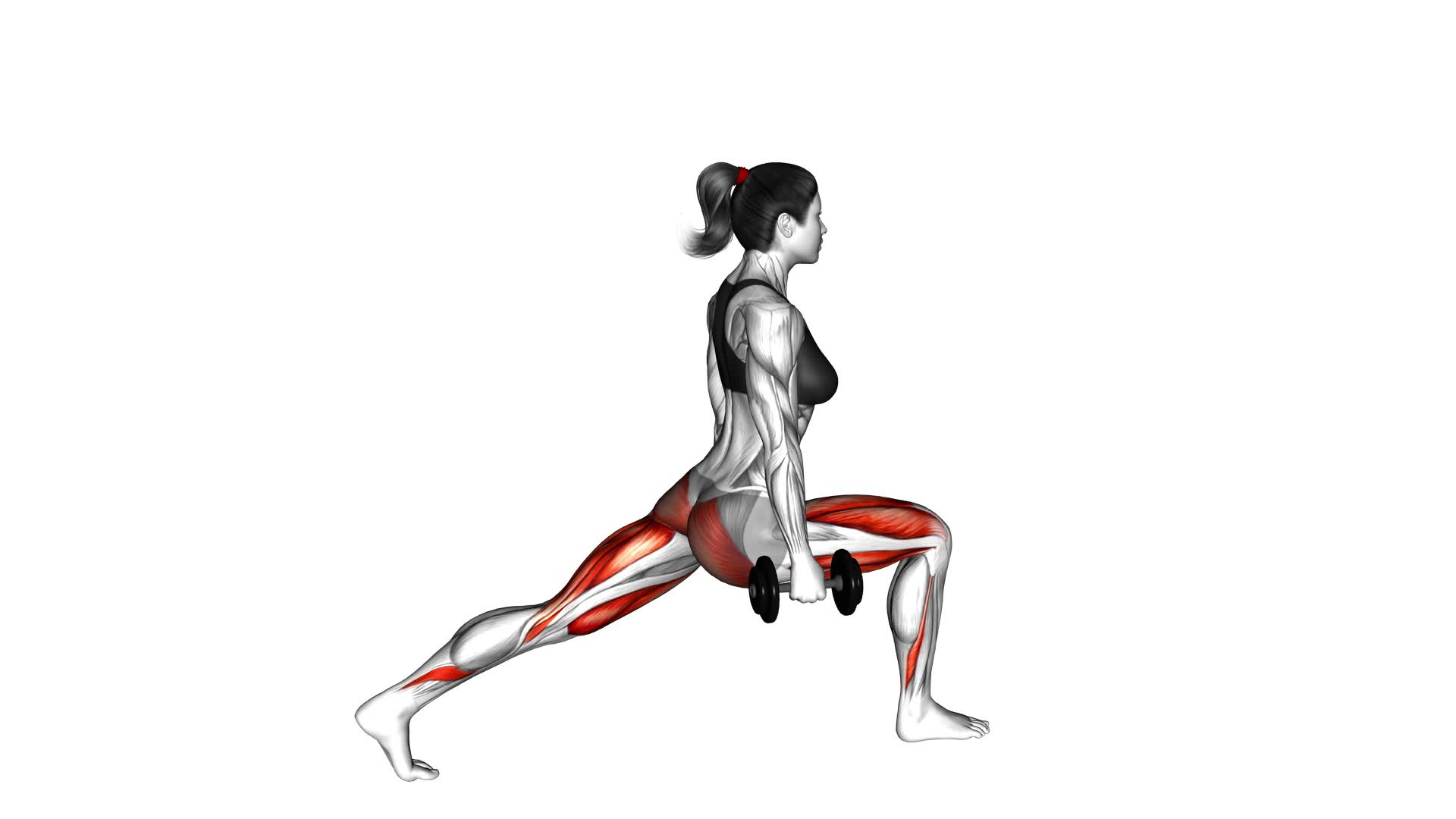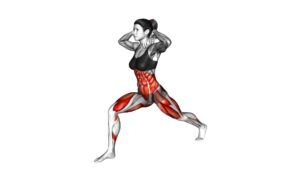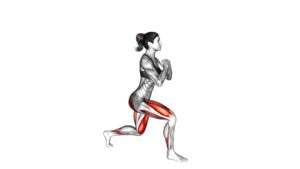Dumbbell Split Lunge Stretch – Video Exercise Guide & Tips

Are you looking for a dynamic lower body exercise that targets multiple muscle groups? Look no further than the dumbbell split lunge stretch!
Watch This Exercise Video
This video exercise guide and tips will show you how to perform this effective move with proper form and technique. Discover the benefits of incorporating dumbbell split lunges into your routine, and learn how to avoid common mistakes.
Plus, we'll share variations and tips to help you maximize your results. Get ready to level up your workout!
Key Takeaways
- Targets multiple muscle groups simultaneously
- Increases muscle activation
- Enhances flexibility
- Strengthens lower body
Benefits of the Dumbbell Split Lunge Stretch
What are the benefits of the Dumbbell Split Lunge Stretch for you?
The Dumbbell Split Lunge Stretch is a fantastic exercise that offers numerous benefits for your body. One of the main advantages of this stretch is that it targets multiple muscle groups simultaneously, leading to increased muscle activation. By incorporating dumbbells into the stretch, you can further enhance the benefits by adding resistance to the exercise. This helps to increase the intensity and challenge your muscles even more.
Another benefit of the Dumbbell Split Lunge Stretch is that it helps to improve your flexibility. This stretch targets your hip flexors, hamstrings, and quadriceps, which are all crucial muscle groups for maintaining flexibility and mobility in your lower body. By regularly performing this stretch, you can gradually increase your range of motion and improve your overall flexibility.
Furthermore, the Dumbbell Split Lunge Stretch is a great addition to your workout routine if you're looking to strengthen your lower body. This exercise primarily targets your glutes, quads, and hamstrings, helping to build strength and stability in these muscle groups. The added resistance from the dumbbells can further enhance the strength-building benefits of this stretch.
Proper Form and Technique
When performing the dumbbell split lunge stretch, it's important to focus on proper form and technique. This includes maintaining proper alignment, engaging your core, and breathing correctly throughout the exercise.
Importance of Alignment
To achieve optimal results and prevent injury, maintaining proper alignment is crucial during the dumbbell split lunge stretch. Proper alignment ensures that your body is in the correct position to effectively target the muscles and joints involved in the exercise. It also helps to minimize the risk of strain, sprain, or other injuries.
Here are some key reasons why alignment is important during this exercise:
- Muscle engagement: Proper alignment allows for the correct activation of muscles, maximizing their engagement and effectiveness.
- Joint stability: Maintaining alignment helps to stabilize the joints, reducing the risk of injury and promoting safe movement.
- Balance and control: Proper alignment enhances your balance and control, allowing you to perform the exercise with stability and precision.
- Posture improvement: By focusing on alignment, you can improve your overall posture, contributing to better body mechanics and reducing the risk of chronic pain or injury.
- Efficient movement: With proper alignment, you can move efficiently and effectively, optimizing the benefits of the dumbbell split lunge stretch.
Breathing and Core Engagement
To engage your core and maintain proper form during the dumbbell split lunge stretch, focus on your breathing and core engagement. Proper breathing techniques help to stabilize your core and enhance your overall performance.
As you perform the exercise, exhale as you lower yourself into the lunge position and inhale as you return to the starting position. This controlled breathing will help you activate your core muscles and maintain stability throughout the movement.
Additionally, it's important to engage your core by consciously contracting your abdominal muscles. This will provide a solid foundation and support for your spine.
By incorporating proper breathing techniques and core activation, you can maximize the benefits of the dumbbell split lunge stretch.
Now, let's move on to discuss common mistakes to avoid.
Common Mistakes to Avoid
To ensure proper form and technique during the dumbbell split lunge stretch, it's important to avoid these common mistakes:
- Allowing your front knee to extend past your toes: This puts unnecessary strain on the knee joint and can lead to injury.
- Leaning too far forward: This can cause your back to arch and put stress on your lower back. Keep your torso upright and engage your core.
- Neglecting to engage your glutes: Squeezing your glutes helps stabilize your hips and ensures proper alignment.
- Using too much weight: Start with lighter dumbbells and gradually increase the weight as you build strength and stability.
- Rushing through the exercise: Take your time to perform the split lunge stretch with control and precision to maximize its benefits and prevent injury.
By avoiding these common mistakes, you can minimize the risk of injury and achieve optimal results from the dumbbell split lunge stretch.
Now, let's move on to the next section and discuss choosing the right dumbbell weight.
Choosing the Right Dumbbell Weight
You should frequently assess and select the appropriate dumbbell weight for your split lunge stretch. Choosing the right weight is crucial to ensure you're challenging your muscles without compromising your form or risking injury.
To determine the suitable weight, start with a lighter dumbbell and gradually increase the weight as you become more comfortable and confident in performing the exercise.
Proper warm-up techniques are essential before attempting the split lunge stretch. Engage in dynamic movements such as leg swings, hip circles, and walking lunges to warm up your lower body and increase blood flow to the muscles.
As you progress in the dumbbell split lunge stretch, you can increase the weight incrementally. Listen to your body and only increase the weight when you feel ready to take on a greater challenge.
Common Mistakes to Avoid
One common mistake to avoid when performing the dumbbell split lunge stretch is allowing your knee to extend beyond your toes. This can put unnecessary strain on your knee joint and increase the risk of injury. To ensure proper form and avoid this mistake, focus on keeping your front knee directly above your ankle throughout the movement.
Here are some other common mistakes to avoid when performing the dumbbell split lunge stretch:
- Leaning too far forward: Keep your torso upright and engage your core muscles to maintain stability.
- Not using a proper range of motion: Lower your back knee towards the ground until it's just above the floor. This will ensure that you're fully engaging your glutes and hamstrings.
- Neglecting the back leg: Make sure to keep your back leg straight and engaged. This will help to stretch the hip flexors and improve overall balance.
- Using improper weights: Choose dumbbells that challenge you but still allow you to maintain proper form. Using weights that are too heavy can compromise your technique and increase the risk of injury.
- Rushing through the exercise: Take your time and focus on controlled movements. This will help to maximize the benefits of the stretch and prevent any unnecessary strain.
Variations to Spice Up Your Workout
Looking to add some excitement to your workout routine?
Try incorporating new workout challenges and creative exercise modifications.
By introducing variations to your exercises, you can keep your workouts fresh and prevent boredom.
Plus, trying different movements can target different muscle groups and help you achieve a more well-rounded fitness routine.
New Workout Challenges
To add some excitement to your workout routine, try incorporating new workout challenges that will keep you motivated and engaged. Here are some variations to spice up your workouts:
- High-Intensity Interval Training (HIIT): Integrate short bursts of intense exercise with periods of rest to increase workout intensity and burn more calories.
- Circuit Training: Combine different exercises into a circuit and perform them consecutively with minimal rest to keep your heart rate up and challenge your muscles.
- Plyometrics: Incorporate explosive movements like jumps, hops, and bounds to activate more muscle fibers and improve power and agility.
- Supersets: Perform two exercises back-to-back without resting to target different muscle groups and maximize muscle activation.
- Functional Training: Focus on exercises that mimic real-life movements to improve overall strength, stability, and coordination.
Creative Exercise Modifications
To add variety to your workout routine, try incorporating creative exercise modifications that will spice up your workouts. Modification ideas can help you challenge your body in new ways and prevent boredom from setting in.
Advanced modifications, in particular, can take your fitness journey to the next level. For example, you can try adding weights to your exercises to increase the intensity and build strength. Another option is to incorporate stability equipment, such as a balance board or a Bosu ball, to work on your core stability and balance.
Additionally, you can experiment with different tempos, ranges of motion, or even try plyometric versions of your favorite exercises. These modifications can keep your workouts interesting, engaging, and effective.
Now, let's move on to the tips for maximizing your dumbbell split lunge stretch.
Tips for Maximizing Your Dumbbell Split Lunge Stretch
To maximize your dumbbell split lunge stretch, focus on maintaining proper form and engaging your core throughout the exercise. This won't only help you to get the most out of the stretch but also prevent injury.
Here are some tips to help you maximize your dumbbell split lunge stretch:
- Start with lighter dumbbells: Using lighter dumbbells will allow you to focus on your form and balance without straining your muscles.
- Keep your back straight: It's important to maintain a straight back throughout the exercise to prevent any unnecessary strain on your spine.
- Engage your core: By actively engaging your core muscles, you'll improve your balance and stability during the exercise.
- Focus on your front leg: Put more weight on your front leg to target the stretch in your front thigh and hip flexors.
- Gradually increase the weight: As you become more comfortable with the exercise, you can gradually increase the weight of the dumbbells to further challenge your muscles.
Frequently Asked Questions
How Many Sets and Reps Should I Do for the Dumbbell Split Lunge Stretch?
For optimal results with the dumbbell split lunge stretch, it's recommended to start with 2-3 sets of 10-12 repetitions per leg. This will help improve flexibility and strength in your lower body.
As you progress, you can increase the number of sets or reps to challenge yourself further.
For advanced variations, you can try adding more weight to the dumbbells or incorporating plyometric jumps into the lunge.
Remember to listen to your body and adjust the intensity as needed.
Can Beginners Perform the Dumbbell Split Lunge Stretch?
Yes, beginners can perform the dumbbell split lunge stretch. This exercise can be modified to suit your fitness level by using lighter weights or no weights at all.
The dumbbell split lunge stretch offers several benefits, including improved lower body strength, increased flexibility, and better balance. It targets your glutes, quads, and hamstrings, making it a great addition to any workout routine.
Remember to start slowly and listen to your body to avoid injury.
Is It Necessary to Use Dumbbells for This Exercise, or Can I Do It Without Weights?
You can definitely perform the split lunge stretch without using dumbbells. It isn't necessary to add weights to this exercise, as the focus is on stretching and flexibility rather than strength training.
Doing the exercise without weights can still provide benefits such as improving hip flexibility, strengthening the lower body, and increasing stability.
Beginners can start with bodyweight only and gradually progress to using dumbbells as they gain strength and confidence.
Can the Dumbbell Split Lunge Stretch Help With Improving Flexibility?
Improving flexibility is one of the benefits of the dumbbell split lunge stretch. By incorporating dumbbells into this exercise, you can add resistance and deepen the stretch, allowing for greater range of motion and flexibility gains.
The split lunge stretch targets the hip flexors, quads, and hamstrings, promoting increased flexibility in these areas. Adding dumbbells also helps to strengthen and tone the muscles involved, making it a beneficial exercise for overall lower body conditioning.
Are There Any Modifications or Alternatives for Individuals With Knee or Hip Issues?
If you have knee or hip issues, there are modifications and alternatives available for the dumbbell split lunge stretch. It's important to prioritize your safety and comfort.
For knee issues, you can try doing a stationary lunge or using a stability ball for support.
If you have hip issues, you can opt for a standing hip abduction exercise or a seated hip adduction exercise.
Remember to consult with a professional before trying any new exercises.
Conclusion
In conclusion, the dumbbell split lunge stretch is a beneficial exercise for improving lower body flexibility and strength.
By maintaining proper form and technique, choosing the appropriate dumbbell weight, and avoiding common mistakes, you can maximize the effectiveness of this stretch.
Additionally, incorporating variations into your workout can add variety and challenge.
Remember to always prioritize safety and listen to your body's limits.
Keep up the great work and enjoy the benefits of this exercise!

Author
Years ago, the spark of my life’s passion ignited in my mind the moment I stepped into the local gym for the first time. The inaugural bead of perspiration, the initial endeavor, the very first surge of endorphins, and a sense of pride that washed over me post-workout marked the beginning of my deep-seated interest in strength sports, fitness, and sports nutrition. This very curiosity blossomed rapidly into a profound fascination, propelling me to earn a Master’s degree in Physical Education from the Academy of Physical Education in Krakow, followed by a Sports Manager diploma from the Jagiellonian University. My journey of growth led me to gain more specialized qualifications, such as being a certified personal trainer with a focus on sports dietetics, a lifeguard, and an instructor for wellness and corrective gymnastics. Theoretical knowledge paired seamlessly with practical experience, reinforcing my belief that the transformation of individuals under my guidance was also a reflection of my personal growth. This belief holds true even today. Each day, I strive to push the boundaries and explore new realms. These realms gently elevate me to greater heights. The unique combination of passion for my field and the continuous quest for growth fuels my drive to break new ground.







